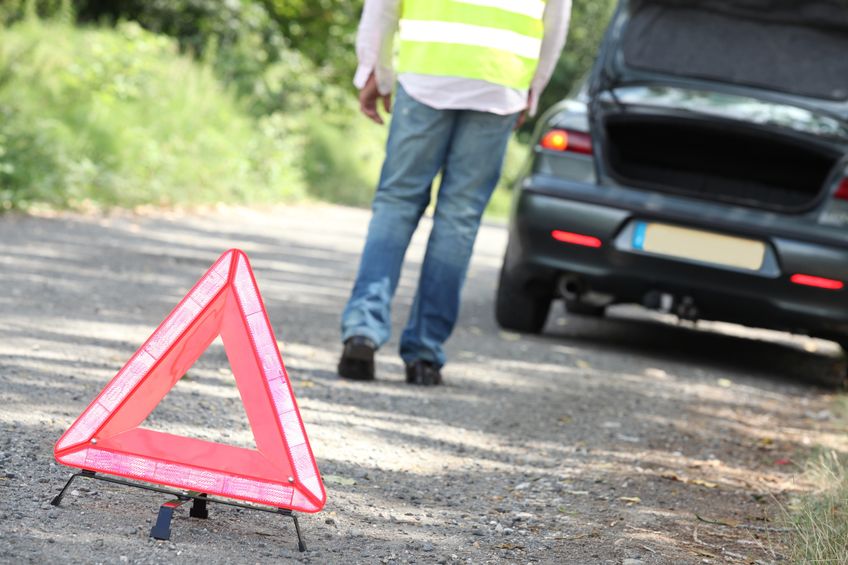Emergency Preparedness - What should you have in your vehicle?

It's important to keep emergency supplies in your vehicle at all times. When people think about this subject what comes to mind is jumper cables, road flares, tire pressure gauge etc; items that are directly related to the maintenance of your vehicle. Expanding on that, having water, food, first aid and warm clothes very important. The idea here is, what items do you need to survive unforeseen circumstances?
The Basics
- Water (Bottles or emergency drinking water pouches)
- Food (Granola bars, jerky and crackers are good choices)
- Battery Jump Start System (This covers multiple uses. It includes the battery to jump start your vehicle, cables and light. The advanced ones have a tire pressure gauge, compressor and a DC outlet that you can plug in smaller electronic devices)
- First Aid Kit (Any pre-made kit will do but I recommend adding blood clotting agent, elastic bandages and flu mask)
- Tool Kit (Any pre-made kit will do)
- Vehicle escape tool (I highly recommend the ResQMe tool)
- Sanitation (Hand Sanitizer or wipes)
- Duct Tape
- Fire extinguisher
- Flashlight
- Road Flares
- Blanket (100% Wool is excellent)
- Rain poncho
- Work Gloves
- Frost Scrapper
The wilderness survival kit is the core of what you will need to temporarily survive away from civilization. It's important to note that is it meant to be complimented with survival skills.
Wilderness Survival Kit
- 5 Liter Water Proof Stuff Sack (I chose orange for all my items for visibility)
- Emergency Blanket and Bivvy (shelter)
- Bank line and Para cord (making shelter)
- 27 oz. stainless steel container (boil water)
- Water purification tablets
- First aid kit (Basics plus blood clotting agent, elastic bandage, N95 mask, sun block, insect repellant, hand sanitizer and rubber tourniquet.
- Fishing kit (hooks, lines, bobbers and lures)
- Survival info (Pamphlet, cards and bandanna)
- Duct tape and Zip lock bag (multiple uses)
- Mirror, tin foil and whistle (signal for help)
- Lighter, fire steel and jute twine (starting fires)
- Mini Head Lamp, flashlight and spare batteries
- Mora champanion knife and sharpener
- Map compass
- Spork
- Notepad and pen (writing down ideas and observations)
Living in a remote wilderness area
If you live in a remote wilderness area then you will want to take the wilderness survival kit to a full size level. A good way to think about it is pretend you were either camping or backpacking. What items would you take? The best thing is to actually do those activities and see when items work or don't work. Once you done it several time you can keep all that gear in your vehicle and now you will be set if you had to survive away from home.
- Shelter (Tent, foot print, stakes, sleeping bag, hammock, tarps, cordage and 100% wool blankets)
- Water (Larger supply and multiple ways to purify it)
- Food (Larger supply and Freeze dried meals)
- First aid (Larger supply)
- Flashlights and batteries (Head lamps are great)
- Fire (Lighter and fire steel)
- Cooking (Portable grill or stove. If you have a stove make sure you have a good supply of fuel)
- Knives (Primary survival knife and backup. Make sure they are very good quality)
- Cutting Tool (Portable saw, hatchet or tomahawk)
- Back pack
- Security (High powered rifle, pistol and ammunition)
- Weather radio (Hand cranked)
- Portable shovel
- Camp Towels
Living in extreme cold environments
If you live in an extreme cold environment then you want to focus more on keeping warm and getting unstuck from snow (This list is expanding from the core information provided in this article).
- Extra set of warm clothes (Parka, scarf, hat, gloves, wool sweater, pants, thermal underwear, wool socks and boots)
- Snow Shovel
- Rock salt and sand
- Chains and rope
Living in dessert environments
If you live in a desert environment then you want to focus more on hydration and sun protection (This list is expanding from the core information provided in this article).
- Water (Large containers)
- Hat, sunglasses and sun block
- Sunblock tarps (Keep the sun off you)
Final thought
The information I provided in this article is an extensive list of items you should have in your vehicle. It's important to really think about this subject. How often do you drive hundreds of miles from your home in unfamiliar territory? If you were to break down and no immediate help is on the way you want to make sure you are protected and comfortable until help arrives.